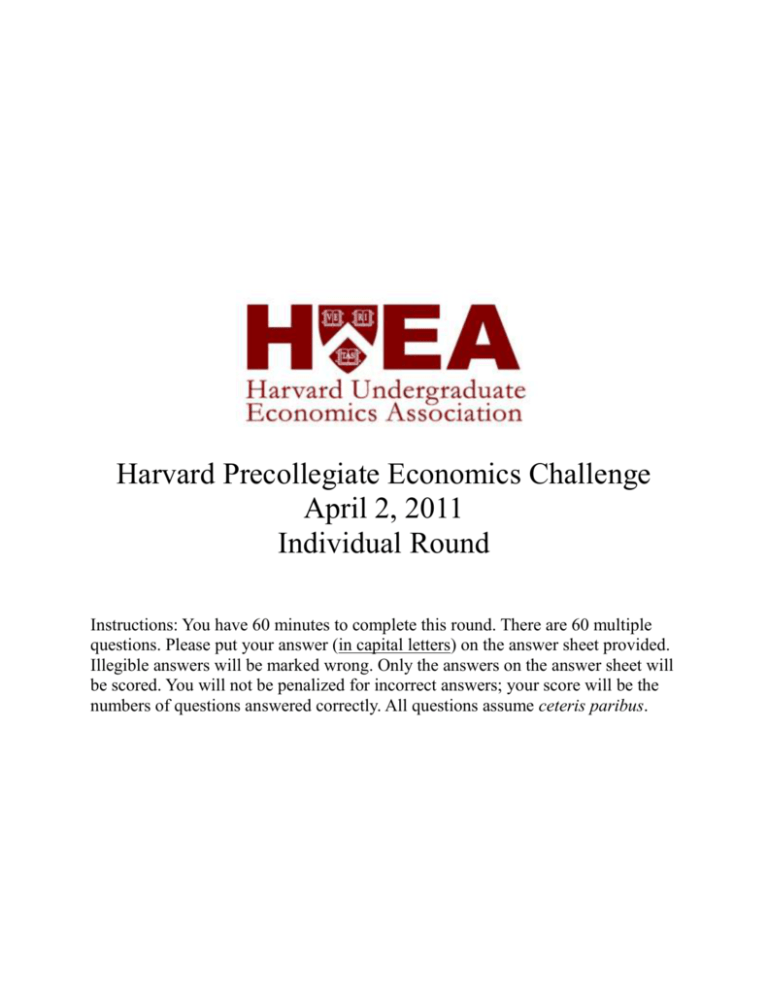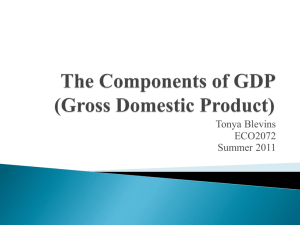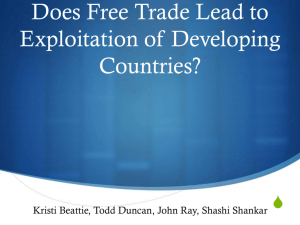HPEC 2011 Multiple Choice Questions
advertisement

Harvard Precollegiate Economics Challenge April 2, 2011 Individual Round Instructions: You have 60 minutes to complete this round. There are 60 multiple questions. Please put your answer (in capital letters) on the answer sheet provided. Illegible answers will be marked wrong. Only the answers on the answer sheet will be scored. You will not be penalized for incorrect answers; your score will be the numbers of questions answered correctly. All questions assume ceteris paribus. 1. Which of the following is NOT an automatic stabilizer? (a) Medicare (b) Medicaid (c) Unemployment benefits (d) Progressive income tax 2. The following is the income tax schedule of Country A. Household Annual Income Marginal Tax Rate 0~$10,000 0% $10,000~$50,000 25% $50,000 and above 50% In the absence of any deductions, what is the effective tax rate on a household that makes $100,000? (a) 25% (b) 30% (c) 35% (d) 40% 3. Which of the following is NOT cited as a reason CPI tends to overstate inflation? (a) CPI does not allow for substitution for cheaper goods (b) CPI does not capture quality increases perfectly (c) CPI does not capture introduction of new, cheap technology perfectly (d) Value of Social Security payments and interest paid on Treasury Inflation Protected Securities depend on CPI 4. There is a tiny country in the middle of the Atlantic with a population of four: Will, David, Jennifer, and Doreen. Will is fourteen years old and is a high school freshman. David is working full time as a banker. Jennifer lost her job three weeks ago and is actively looking for a job. Doreen has large savings, does not work, and does not wish to work. What is the unemployment rate in this country? (a) 25% (b) 33% (c) 50% (d) 100% 5. Which of the following is a complete and accurate list of components of M1? (a) Currency (b) Currency and demand deposits (c) Currency, demand deposits, traveler’s checks, and other checkable deposits (d) Currency, demand deposits, traveler’s checks, other checkable deposits, and money market mutual funds 6. Assume that the private demand for loanable funds is: Q=500-40r, where Q=amount of money loaned out (in $) and r=interest rate (in % per year) The supply of loanable funds is fixed at $300. At the beginning, the government has a balanced budget and does not borrow. Now, suppose that the government runs a budget deficit and must borrow $200 in the loanable funds market. Assume that the private demand remains the same. What happens to the percentage of loanable funds that goes to the private sector? (a) It falls from 100% to 50% (b) It falls from 100% to 33.3% (c) It falls from 50% to 33.3% (d) It falls from 100% to 0% 7. Which of the following is NOT cited as a reason why unemployment exists? (a) Collective bargaining and unions (b) Theory of efficient wages (c) Imperfect job matching (d) Existence of retired workers 8. John has a utility curve in the following form: U=W2, where U=utility and W=wealth, for all nonnegative wealth. What is John’s attitude toward risk? (a) Risk averse (b) Risk neutral (c) Risk seeking (d) Risk averse at low wealth and risk seeking at high wealth 9. In 2010, the government of Country A, a closed economy, ran a budget deficit of $10 billion. Consumption in Country A was $20 billion, GDP was $40 billion, and government expenditure was $15 billion in 2010. What was Country A’s private saving in 2010? (a) $5 billion (b) $10 billion (c) $15 billion (d) $20 billion 10. In 2010, the Republic of Cambridge, a closed economy, had the following economic data: GDP=80 Consumption=70 Government expenditure=6 Investment in the Republic of Cambridge is determined by I=10-r, where I=investment and r=interest rate. Calculate the equilibrium interest rate. (a) 4% (b) 5% (c) 6% (d) 7% 11. Which of the following is true about the Federal Funds Rate? (a) It is set by individual regional Federal Reserve Bank presidents. (b) It is the rate at which banks can borrow from the Federal Reserve (c) The Federal Reserve has perfect control over the precise level of the Federal Funds Rate (d) The Federal Reserve changes the Federal Funds Rate primarily through open market operations 12. A 10% decrease in the price of a good reduces the quantity demanded of that good by 1%. Which of the following statements is most applicable to that good? (a) Consumers view this good as a luxury (b) This good has many close substitutes. (c) This good is a Giffen good. (d) Demand for this good is elastic 13. A drop in the price of flour and an increase in the price of jam will most likely cause what to occur in the bread market? (a) Increase the equilibrium price of bread (b) Increase the equilibrium quantity of bread (c) Decrease the equilibrium price of bread (d) Decrease the equilibrium quantity of bread 14. Billy considers apples as normal goods and bananas as inferior goods. If his income falls, his demand for apples will ________ and his demand for bananas will ______. (a) increase; increase (b) increase; decrease (c) decrease; decrease (d) decrease; increase 15. A small country currently exports grain. A technological advance in grain production that occurs only in that country will likely: (a) cause them to import, rather than export, grain. (b) reduce but not eliminate exports from that country. (c) increase exports from that country (d) not change exports from that country because the world price of grain has stayed the same 16. According to the theory of tax incidence, (a) the less elastic side of the market bears a larger fraction of the per-unit tax burden (b) the less elastic side of the market bears a smaller fraction of the per-unit tax burden (c) per-unit tax burdens are always shared equally between consumers and producers. (d) one side always bears the entire tax burden 17. A per-unit tax is imposed on a perfectly competitive market. If market demand is less elastic, the burden to consumers is _____ and government revenue is _____ (a) smaller; smaller (b) smaller; larger (c) larger; larger (d) larger; smaller 18. A per-unit subsidy to the producers of corn would cause the market price of corn to _____ and the quantity sold to ____ (a) increase; increase (b) increase; decrease (c) decrease; increase (d) decrease; decrease 19. The government announces that a certain product lowers cholesterol while simultaneously a cheaper production method for the product has been discovered. What is most likely to occur to the market for the product? (a) Equilibrium price will increase (b) Equilibrium price of will decrease (c) Equilibrium quantity will increase (d) Equilibrium quantity will decrease 20. Adam Smith once wrote that “it is not from the benevolence of the butcher, the brewer, or the baker that we expect our dinner…” According to Smith, from whom do we expect our dinners? (a) Collective interests of the mercantilists (b) Government production of meat, beer, and bread (c) Government altruism (d) The self-interests of the butcher, brewer, and baker 21. Peanut butter and jelly are complements. Which will likely not cause an increase in the market price of jelly? (a) A drought damages this year’s peanut yields (b) Technological advances in peanut harvesting machinery (c) Congress passes a bill with price floors for peanut crops (d) Both a and c 22. Government regulators set a binding price ceiling for a certain market. Under which of the following scenarios would the resulting shortage of the product be the greatest? (a) Inelastic demand, inelastic supply (b) Inelastic demand; elastic supply (c) Elastic demand, elastic supply (d) Elastic demand, inelastic supply Please refer to the table for questions 23-24. Number of apples 0 1 2 3 4 5 6 Number of apple pies 0 8 15 20 23 21 21 23.What is the marginal pie product for the 6th apple? (a) 21 (b) 23 (c) 0 (d) 2 24. Each apple pie sells for $5. What is the marginal revenue product of the 4th apple? (a) $5 (b) $15 (c) $20 (d) $25 25. Which country has the highest income inequality based on Gini Coefficient? (a) United States (b) Brazil (c) Canada (d) Japan 26. A consumer spends his income on two goods, pencils and Coke. The price of a pencil is $2. The price of a can of Coke is $4. What is the slope of his budget constraint, given that the horizontal axis represents pencil and the vertical axis represents Coke? (a) -0.5 (b) -1 (c) -2 (d) -4 27. Peter only consumes apples and pens. Peter’s income is $100. The price of an apple is $2. The price of a pen is $1. His consumption of apples is 30, and his consumption of pens is 40 originally. If Peter’s income increases by 10%, and both the prices of apples and pens increase by 10%, what will be his new consumption of apples and pens? (a) 10 apples, 80 pens (b) 20 apples, 60 pens (c) 30 apples, 40 pens (d) 40 apples, 20 pens 28. What is the approximate percentage of consumption in the United States GDP in 2010? (a) 30% (b) 50% (c) 70% (d) 90% 29. What is/are the measure(s) of quality of life? (a) Real GDP (b) Life Expectancy (c) Adult Literacy (d) All of the above 30. The nominal GDP for Country X in 2010 is $121 trillion. GDP deflator in base year was 100 and is 110 in 2010. What is the real GDP in base year dollars? (a) $100 trillion (b) $110 trillion (c) $133.1 trillion (d) $140 trillion 31. Sally earned $50 a day in 1970. If the consumer price index was 10 in 1970 and 23 in 2010, how much is Sally’s salary worth in 2010 dollars? (a) $63 (b) $115 (c) $187 (d) $230 32. Which of the following statements about GDP is false? (a) It includes bread sold to a supermarket customer (b) It does not include child care provided by parents (c) It includes stocks sold on the NYSE (d) It does not include the value of the used car you sell to your friend 33. Assume that NX=0 and G=0. If C = 100 + 0.5Y and I=50, what is the equilibrium level of Y? (a) 300 (b) 500 (c) 600 (d) 700 34. Investment as measured in the national income accounts is: (a) Stocks, bonds and other financial assets (b) Real estate and financial assets (c) New capital equipment, inventories, structures and new housing (d) Financial assets, new capital equipment, inventories, structures and new housing 35. Which of the following best describes adverse selection? (a) The tendency of a person who is imperfectly monitored to engage in dishonest or otherwise undesirable behavior (b) A problem that arises when the seller knows more about the attributes of the good being sold than the buyer does (c) The failure of majority voting to produce transitive preferences for society (d) Behavior of an agent hired by the principal that undermines the principal’s goals 36. In a seaside town, the local fishing activities and fish markets create a stench that spreads throughout the town. Residents are unhappy, so the local government decides to intervene. By which method will they efficiently limit fishing activities and the fish markets? (a) A tax on consumption of fish (b) A subsidy on consumption of fish (c) A tax on fishing (d) A subsidy on fishing 37. Which of these is NOT a necessary condition of the Coase Theorem? (a) Transaction costs between the parties in question are minimal. (b) Governmental oversight must not hold a conflict of interest (c) Property rights are clearly defined. (d) Society allows complete contracts and lawsuits 38. Common resources are: (a) Excludable and non-rival in consumption (b) Non-excludable and non-rival in consumption (c) Excludable and rival in consumption (d) Non-excludable and rival in consumption 39. One key characteristic of a natural monopoly is (a) Declining average total costs (b) Diseconomies of scale (c) Economies of scope (d) Low fixed costs 40. With a downward sloping demand curve, if a firm finds that its marginal revenues exceed average variable costs but are below average total costs, then which of the following will happen in the short run? (a) The firm will cease production (b) The firm will continue production (c) There is not enough information to determine the firm’s behavior (d) The firm will definitely exit the market 41. If identical firms exist in a perfectly competitive market, and each firm produces 2500 widgets for $10,000, at what price per widget will there be a zero net inflow of firms to the market? (a) $3.00 (b) $4.00 (c) $5.00 (d) $6.00 42. In the following scenario, which describes a Nash equilibrium? Utilities are given as (A, B). Country B War Country A War (a) (-10,-10) Peace (c) (-15, 1) Peace (b) (10, -5) (d) (1, 1) 43. A marketplace dominated by a few major firms, each with some market power, can be characterized as a(n) (a) Oligopoly (b) Perfectly competitive market (c) Monopolistically competitive market (d) Monopoly 44. Demand for a certain product under a monopoly is given by Q = 10 – P/2, where P is denoted in $/unit. If the cost per unit to the monopoly is $4/unit, and there are no fixed costs, what price should the monopolist charge per unit of the product? (a) $9.00 (b) $10.00 (c) $11.00 (d) $12.00 45. Unlike perfect competition, in monopolistic competition, firms most likely can (a) Set prices (b) Collude (c) Differentiate products (d) Price discriminate 46. According to the National Bureau of Economic Research, the most recent recession in the US was from: (a) Q2 2007 – Q4 2009 (b) Q4 2007 – Q2 2009 (c) Q2 2006 – Q2 2009 (d) Q4 2007 – Q1 2010 47. Which of the following would most likely coincide with a decline in GDP? (a) A decrease in welfare payments (b) An increase in housing starts (c) A decrease in the number of airline passengers (d) An increase in the volume of trash collected nationwide 48. In the long run, the price level affects: (a) Output capacity (b) Real GDP (c) Aggregate supply (d) Government tax revenue 49. A recession occurs from a _____ to a _____ in economic output (a) trough, peak (b) peak, trough (c) shutdown, resumption (d) resumption, shutdown 50. Deflation, in the short run, is likely to result in... (a) A decline in output (b) A decline in unemployment (c) Increase in price level (d) Decrease in real interest rate 51. If US were to go into a recession, what would happen to China’s GDP and net exports? (a) China’s GDP rises, China’s net exports rise (b) China’s GDP falls, China’s net exports rise (c) China’s GDP rises, China’s net exports fall (d) China’s GDP falls, China’s net exports fall 52. Stagflation results when... (directions refer to a price level vs. output graph) (a) the aggregate supply curve shifts up (b) the aggregate supply curve shifts down (c) the aggregate demand curve shifts up (d) the aggregate demand curve shifts down 53. Aggregate demand... (a) directly relates the price level and the quantity of output (b) inversely relates the price level and the quantity of output (c) directly relates unemployment and the quantity of output (d) inversely relates unemployment and the quantity of output 54. Assuming no crowding out and a marginal propensity to consume of 0.8, how much would a government purchase of $1 billion contribute to GDP? (a) $800 million (b) $1.8 billion (c) $4 billion (d) $5 billion 55. Sticky-wage theory and sticky-price theory help to explain: (a) the relationship between supply and demand (b) the relationship between the price level and changes in aggregate demand (c) the relationship between the price level and changes in aggregate supply (d) the relationship between output and unemployment 56. Keynes advocated stabilizing the economy with: (a) monetary policy only (b) government expenditures only (c) fiscal policy only (d) fiscal and monetary policy 57. The Federal Reserve’s dual mandate refers to responsibility for controlling... (a) inflation and asset prices (b) inflation and the money supply (c) GDP and unemployment (d) inflation and unemployment 58. The crowding-out effect refers to... (a) as prices rise in one market, consumers have less money to spend elsewhere (b) as taxes rise, public- sector activity replaces private-sector activity (c) as government borrowing and spending rise, interest rates rise, and investment declines (d) as GDP rises in one country, its exports drive down GDP in other countries 59. The world price of steel is $5 per ton. In Country A, the demand for steel is Q=20-P, where Q is in tons and P is in dollars per ton. The domestic supply is Q=P. There is no transportation cost associated with international steel trade. At the beginning, Country A has free trade. Now, Country A decides to adopt a $2 per ton tariff on steel. What is the change in total welfare of Country A? (a) No change (b) Decrease of $2 (c) Decrease of $3 (d) Decrease of $4 60. BMC Theater faces two types of customers, children and adults. Children’s demand curve for movie tickets is Q=50-P and adults’ demand curve for tickets is Q=200-4P. There is no fixed cost, and BMC Theater faces constant marginal cost of $10 per ticket and is a monopolist. In 2009, BMC was allowed to price discriminate between children and adults. In 2010, as a result of changes in antitrust law, BMC is no longer allowed to price discriminate and must charge the same price for children and adults. What is the change in consumer surplus? (a) Increase of $500 (b) Increase of $200 (c) Increase of $100 (d) No change







